create powerful
online events
that connect
with your audience
StoryMine is currently accepting inquiries about
Event Storytelling Design partnerships for spring 2022 events.
The trouble with online events is this
After attending online events for several months, we noticed a pattern — online events in the nonprofit space are connecting about really important things, but they are not engaging people emotionally.
It clicked for us that the reason that these events were falling flat, is because we are all thinking about online events as if they were in-person events. And they very much are not.
Chats, polls, and break-out rooms aside, for the most part attending an online event is a solitary viewing experience. It’s a person, sitting, watching content that’s presented to them through a video screen.
What if instead of thinking of online events like in-person events, we started thinking about them as what they really are — a video experience?
Video is an incredibly powerful tool for connecting with your audience
By its very nature, video storytelling brings us closer to issues and experiences we are not physically there for, making it tremendously useful for supporting the work that drives social change. This is especially needed during a pandemic, when digital connection is all we’ve got.
Whether you’re organizing intimate donor meetings, educational conferences, or large political action events, this article will guide you through some of the key strategies for reimagining your online event by leveraging powerful video content. Throughout the article we’ve included excerpts from the companion workbook to the workshop that inspired this article. You can request the full workbook here.
Before we get into the strategies for using video stories in online events…
Let’s talk about why video storytelling works
If you have a minute, I encourage you to watch this short video by Future of Storytelling. If you don’t have time to watch it right now, here’s the gist: Stories change our brains.
When information is presented as a story, our connection to it is completely different than our connection to the same information when it is laid out without the critical elements of story.
And yet, so often when organizations use video to communicate they don’t tell a story. They tell a list of facts. “Our mission is this and this, we do this, this, and this,” and so on.
But what makes a video compelling is not the list of information. It’s the journey, it’s the change, it’s the reflection on that journey. And the strategic key is how you connect that story to the information you want to share. We dive into some specific strategies for creating strong story-centered videos in this article.
So with that in mind, let’s get into some of the strategies for using video storytelling to improve your online event.
Strategy 1 — The Pivotal Moment (or the inciting incident)
One of the questions we always ask in an interview is. “Was there a moment that drew you to this work?” What we’re looking for with that question is the inciting incident, the moment in the person’s life that started them down the path that they’re on. As an organization, a powerful way to connect with your audience through storytelling is to share an inciting incident or pivotal moment for the character in the video story.
Showing your audience what this moment was for someone else gets them to reflect on their pivotal moment. What put them on the path that they’re on (in this work, for this issue, etc). Leading them to this reflection gets them to remember their own passion, their own commitment, and where it came from.
That is a really powerful thing to draw out in people.
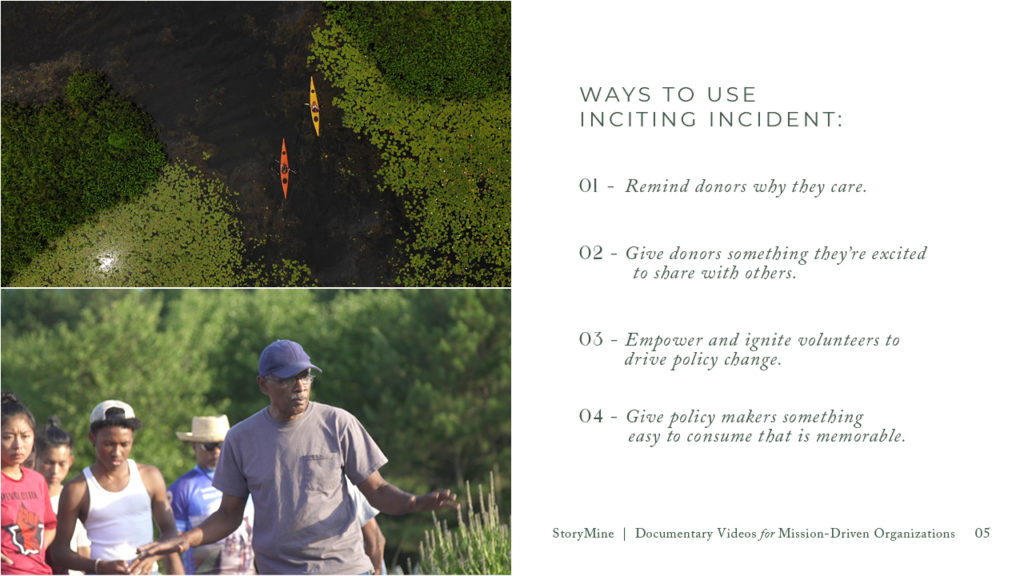
The pivotal moment also also answers the “Why should I care?” question. Nonprofit communicators are always fighting against this subtle undertone of, “I’ve got a lot of other stuff to pay attention to, I’ve got a lot of other information I’m processing. Why should I pay attention to this video, why should I pay attention to this event, why should I care?
The pivotal moment or inciting incident gives your audience this answer because it reminds them why they care.
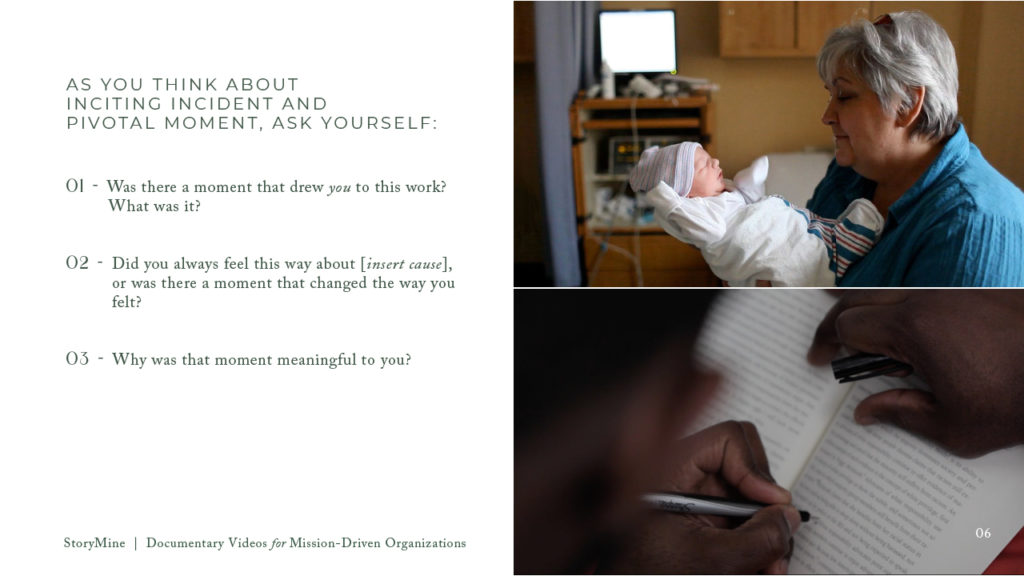
Strategy 2 — Grounding Information-Heavy Events with Story
We’re often asked to create companion pieces for high-impact journal articles or research papers, as a way to ground information-heavy content in something accessible and memorable. Videos like this create an entry point into the topic. Even if your audience is really well versed in the topic, they need to be primed for that information and given a reminder of why they care about this work.
This is also very useful for pacing your event. Video stories give us a moment to soak in the information we’ve been given (by a speaker, a panel, etc). They provide a transition in the event from one topic to the next. And they give us the all important emotional connection to attach to the information we’re consuming, so we remember it and carry it forward.
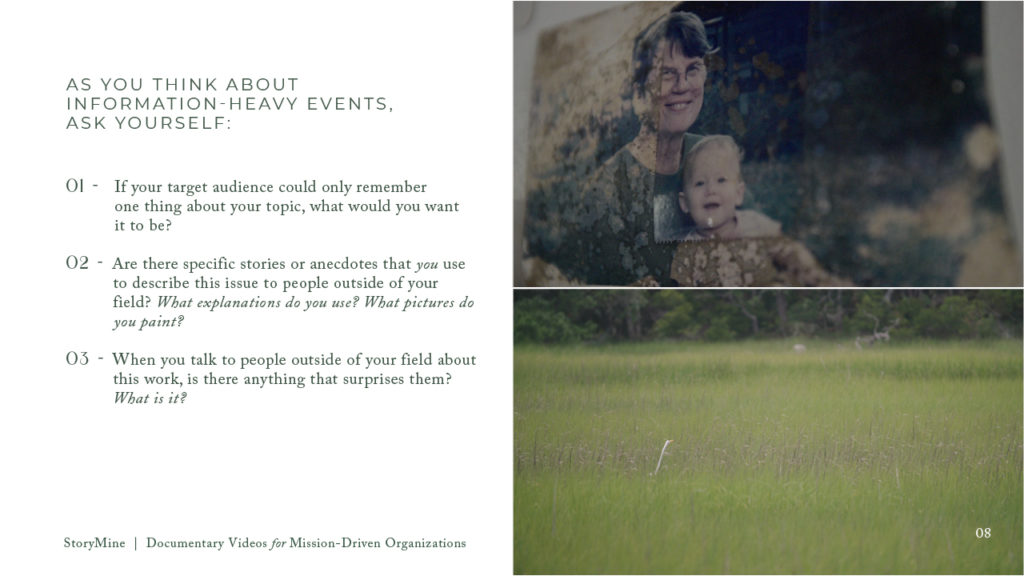
Strategy 3 — Building Your Event Around Story
The thing that got us most excited about this workshop is the idea of helping mission-driven organizations build entire events around a strong story strategy. In other words, creating an online event experience that uses story elements to punctuate a beginning, a middle, and an end. Doing this will transform your online event from a stand-in for the in-person event you can’t hold right now, to an experience built for the medium you’re using, built for video.
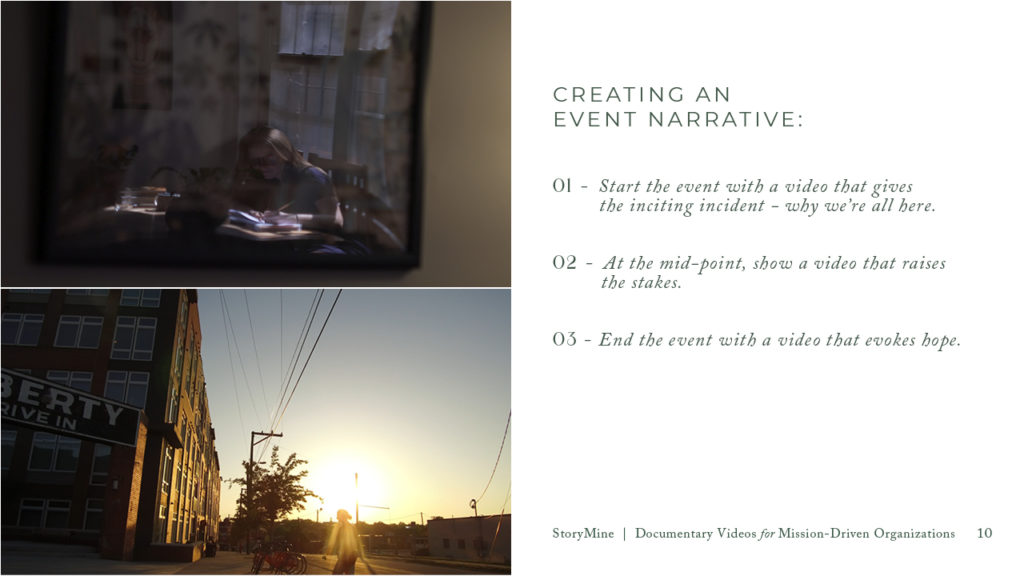
The way to begin creating an experience like this is to think about your event in terms of plot points.
Plot Point 1 — What is the inciting incident for this work?
Imagine you start your event with a video story that presents an inciting incident, a pivotal moment that puts forward this idea of “This is why we’re all here.” That film could be something that is about your organization, it could be something that is a scene from a documentary, it could be something that a partner organization has created about the issue your event is centered on. Whatever it is, you’re using it to set the stage for the event, in a way that’s going to move your audience.
Plot Point 2 — Raising the Stakes
Then you move on to whatever comes next in your event, a panel, a speaker, etc. You continue to move through the structure of your event until you come to a midpoint. Here, you show a video that raises the stakes.
This is the place in the event story where you’re basically saying “We know why we’re all here, we’ve heard some great information, and now we’re going to talk about how we are at a place where change needs to happen.” The video you show here should create a feeling of ‘You thought that inciting incident was the thing that got you moving, wait until you hear about what’s happening now.” You’re making people feel an emotional pull of “we need to do more.”
And sometimes the “Raise the Stakes” moment is because we’re making progress, as opposed to because things are getting worse. You’ll often find this with events centered around research. There, the message might be — This used to be a question that nobody was asking, and now, we’re all asking it because we know how important that is. To figure out what the right “Raise the Stakes” message for your event is, ask yourself: “What moment are we in, what moment is the work in?”
Plot Point 3 — End by Evoking Hope
Now you transition to the next part of your event, maybe it’s more panels, break-out sessions, maybe it’s building to your keynote speaker.
And then the final piece of your event is a video that evokes hope and is your call to action. This is that final emotional connection your audience is attaching to the entire experience that they’ve had through attending your event.
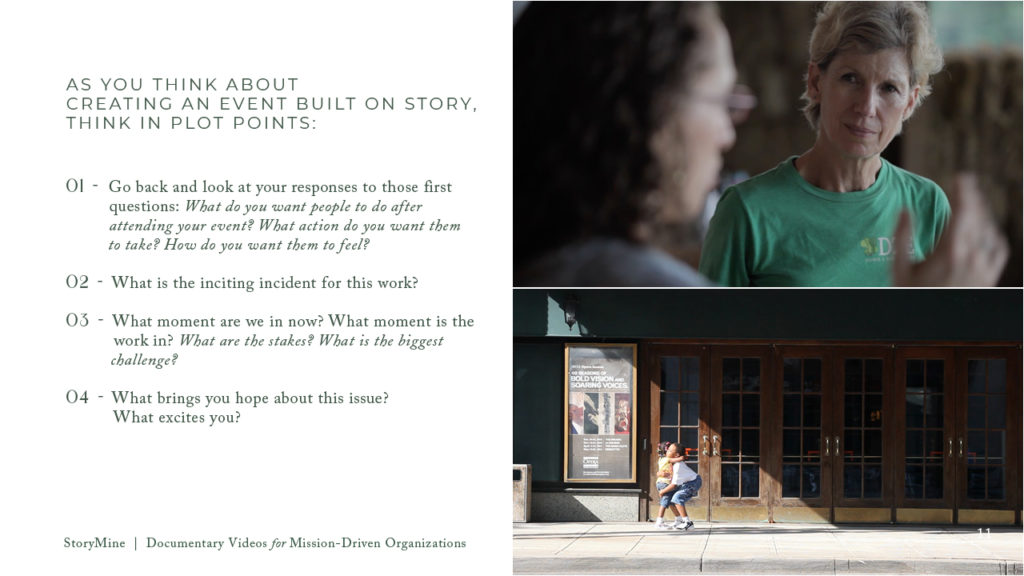
When I leave a powerful in-person event, I am filled with exhilaration and inspiration. I am filled with new found commitment and passion. I leave full of ideas of how I’m going to take this information, these connections, and put them into action.
That feeling is hard to create when the event is online. That same feeling of “I’ve been in this space, with these people, in community and now I’m going back into the world” is really hard to replicate when you’re sitting at home at your computer. But you can re-imagine that experience as a viewing experience. You can create strategies for connecting with people the way film and storytelling are so effective in doing. And if you do that, you can create an online event that is not only different than all the other panel, speaker, PowerPoint-a-thons we’re all slogging through, but actually connects to your audience and creates meaningful impact.